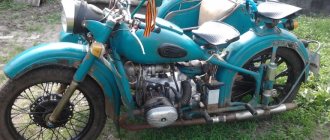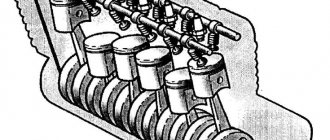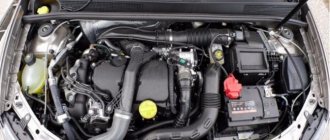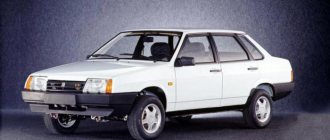- 1. The design of a CVT gearbox and the principle of its operation 1.1.
- 1.2.
- 1.3.
- 2.1.
- 3.1. Pros and cons of a CVT box
To improve the convenience of driving, automakers began to install automatic transmissions instead of classic mechanics.
This gearbox allows the driver not to be distracted from the road situation while changing gears. Hydromechanical and continuously variable transmissions are the most popular automatic transmissions. There is a competitive struggle between them, and the question, variator or automatic - which is better, is still relevant. Both automatic and CVT transmissions have their advantages and disadvantages, so neither type of transmission can completely displace its competitor.
The design of a variable speed transmission and its operating principle
The operating principle of the variator gearbox is based on a smooth change in the gear ratio depending on external conditions. The design of a V-belt variator involves changing the diameter of the pulleys. Structurally, this is realized by the convergence and divergence of two cones mounted on the shaft. The main factors that determine the diameter of the pulley at the point of contact are load and speed.
A variator with a V-belt design includes several main parts:
- Clutch system. The first continuously variable transmissions used a torque converter for connection to the power unit, similar to that used in automatic transmissions. Subsequently, automakers began experimenting with centrifugal and electromagnetic clutches to increase transmission efficiency.
- Shafts with mounted cones of variable diameter. They work under high loads, so they are made of high-strength steel.
Rice. — “V-belt drive”
- Belt or chain. Serves to transmit force between pulleys. It is made of metal strips connected by special shaped parts.
- Transmission fluid. Car manufacturers do not recommend using regular oil for automatic transmissions. Special lubricants are produced for cars with a CVT (for example, DiaQueen CVT, used for Mitsubishi).
Rice. — “Original oil in CVT”
- Hydroblock. Serves to direct the oil supply to the required channel. Lubricant is pumped using an oil pump.
- Filters. As a rule, there are several of them: coarse and fine oil purification, as well as a pair of magnets that catch small metal chips. Filters can be installed both inside the variator and outside its housing.
Rice. — “Fine oil filters”
- Radiator. The CVT operates with more heat than an automatic transmission. Therefore, to prevent thermal destruction of the oil and its additives, cooling using a radiator is required.
- Electronic control unit. Algorithms for selecting the optimal gear ratio and issuing commands to control the variator are assigned to the electronics of the continuously variable transmission. It maintains constant communication with the main ECU module and processes information coming from sensors. The variator control unit can be located both in the variator housing itself and outside it.
Rules and features of variator operation
There is an opinion that a CVT is not the most reliable type of transmission, and its service life, at best, is limited to 100-150 thousand kilometers. The truth, as always, is somewhere in the middle, and with proper and careful use, the box can last much longer.
By following a number of rules, you don’t have to worry about having to make expensive repairs or completely change the variator.
Change the oil in the variator in a timely manner; a lot in its operation depends on the purity and quality of the oil. It performs several important functions at once, including:
- Creation of the thinnest protective film in areas of metal friction;
- CVT cooling;
- Ensuring proper operation through fluid pressure.
If the oil is burnt or clogged with waste products, it stops performing its assigned tasks, which will lead to disruption of the box, rapid wear and tear.
Since in different years, in different markets, on the same cars, manufacturers could install different versions of the CVT, it is better to look for information based on the type of transmission you have, rather than the make of the car.
It would be best to look at the information in the vehicle's owner's manual. But if it is not there, in the table you will find data on what oil is used and how often it should be changed.
Types of variators
According to their design, the following types of variators are distinguished:
- V-belt, which is most widespread;
- chain, which is an analogue of the above type, but with a chain instead of a belt;
Rice. — “Chain variator”
- toroidal, which, due to its complex design, occupies no more than 5-7% of the continuously variable transmission market.
The main difference between a toroidal continuously variable transmission is the absence of a V-belt or chain drive. Torque in such a variator is transmitted using special rollers and cone-shaped disks. Changing the position of the rollers leads to a change in the gear ratio.
The advantage that a CVT with a toroidal transmission has is greater torque than a V-belt design can withstand. This is only possible when using steel of the highest strength and wear resistance, which affects the price of the unit, increasing it.
What is the difference between a CVT and an automatic transmission?
The main difference between a CVT and a classic automatic transmission is the absence of jerks when accelerating. This is due to the fact that the CVT transmits torque during acceleration without the steps that are typical for an automatic transmission.
The differences between a CVT and an automatic transmission are due to the fact that a hydromechanical transmission requires time to switch a pair of working gears. Because of this, the dynamic acceleration performance is worse. The absence of a break in the kinematic connection during acceleration of a car with a CVT allows the continuously variable transmission to accelerate faster.
The engine, if the car has a CVT, operates in a more gentle mode. This is due to the smooth maintenance of crankshaft speed, since acceleration of the car occurs mainly due to a change in the transmission gear ratio. As a result, drivers who switched from automatic and manual transmissions have a poor sense of car speed at first.
Pros and cons of a CVT box
The advantages that cars with CVTs have include the following:
- low fuel consumption - continuously variable transmission has higher efficiency;
- smooth ride, not accompanied by jerks that occur in an automatic transmission when changing gear ratios;
- gentle engine operation.
Despite all the advantages of the variator, its design is not without drawbacks. Because of this, the continuously variable transmission never took a leading position in the auto industry. The disadvantages of the variator are:
- complex repairs that many car services do not undertake;
- limited belt life, the cost of which is quite high;
- complex electronics and high sensitivity to control unit errors;
- high cost of oil.
The pros and cons of a CVT transmission allow them to remain in demand among a narrow circle of car enthusiasts. As a rule, driving with a continuously variable transmission is rarely dynamic. The variator does not like sudden starts from traffic lights and slipping.
Pros and cons of automatic transmission
An automatic transmission has the following advantages over a continuously variable transmission:
- high reliability;
- lower repair cost compared to a CVT;
- ease of repair.
The disadvantages of automatic transmission are:
- changing gears leads to jerking;
- speed is gained more slowly;
- The efficiency is lower, which leads to increased fuel consumption.
It is impossible to say unequivocally which transmission is better. It all depends on the preferences of the individual motorist. If the more important points for the driver are smooth running and optimal fuel consumption, then the choice should be made in favor of the CVT. If the key criteria are durability and higher maintainability of the transmission, then you need to choose an automatic transmission.
Machine
The main thing that structurally distinguishes an automatic from a variator is the presence of a step-shift mechanism. An additional unit requires more oil consumption, more complex design and electronics, and costs for repairs and maintenance. When changing gear, the driver feels slight jolts and hears the “roar” of the engine.
How does automatic transmission work?
The operation of an automatic transmission can be divided into components: clutch, hydraulic system, gear shifting, electronic control.
Read
What happens if you pour ATF oil into an automatic transmission?
Clutch and gears
The role of the clutch in the machine is performed by a torque converter (GDT). It transmits torque from the engine to the transmission through ATF. There is no rigid connection between the power unit and the transmission. The oil dampens engine vibrations and shocks from gear shifting. Improvement of the gas turbine engine makes it possible to give the car sportiness and efficiency by incorporating a lock-up clutch with a friction disc.
The automatic transmission is based on a planetary mechanism consisting of 2 - 4 gearboxes. Each gearbox is a set of gear wheels that are in constant mesh. Rotating some gears and locking others creates different gear ratios. To fix the elements, clutch packs are used.
The clutch package consists of steel discs and soft clutches assembled into a drum. Soft discs are made of cellulose fiber with the addition of graphite and glued with resins. The friction clutches are engaged with a gear mounted on a shaft.
Steel discs are connected to the drum. The input torque is transmitted from the drum to the drive discs. The driven ones rotate independently until a signal to engage the gear is received and the piston is released.
Hydraulics and electronics
The electronic unit receives information from sensors:
- about the position of the selector;
- about the rotational speed of the crankshaft and output shaft;
- about ATF temperature and pressure;
- about the speed of the car;
- about the brake pedal, etc.
The computer analyzes the data and issues impulses for action. The conversion of the electrical signal into hydraulic action occurs in the valve body. It supplies control voltage to the solenoid, and the solenoid valve opens the channel for the passage of transmission fluid.
ATF, under pressure from the oil pump, passes through the oil filter into the channels of the hydraulic plate and enters the piston. Under the pressure of the piston, the clutches and steel discs are compressed, ground in and rotate as a single unit. In this case, the gears of the planetary gearbox begin to rotate in a given order, transmitting torque to the output shaft.
What can break in an automatic transmission?
The design of the machine is manufactured with high precision and is subject to heavy loads. ATF “relieves stress” by lubricating and transferring heat from rubbing components to the radiator. Overheating is dangerous for the box: it leads to aging of the fluid and wear of parts:
- oil seals and seals are leaking;
- bearings, couplings, gears fail;
- the friction disc in the gas turbine engine wears out;
- plastic solenoid housings and bushings melt;
- soft clutches are charred.
Read
Diagram, repair of automatic transmission 4F27E and valve body with your own hands
The oil becomes clogged with friction dust, adhesive detachments, and shavings. The flow spreads dirt throughout the box:
- clogs the oil filter;
- deposits the channels of the valve body and solenoids;
- The radiator is clogged.
The pressure in the system disappears, and the torque is transmitted with losses. Dirt, like an abrasive, abrades the surfaces of parts and eats the splines of gears. Fragments of washers, rings, and blades may get into the oil. In this case, the machine must be seriously repaired or replaced.
Advantages of automatic transmission
The advantages of an automatic transmission are summarized in the table.
| Parameter | Description |
| Economical | Simple repairs: some work can be done yourself; it’s easy to find a specialized service station. It is permissible to use budget analogues as transmission fluid. |
| Fuel consumption | The latest generations of automatic machines consume 7 - 10 liters of gasoline in the combined cycle. |
| Versatility | Automatic machines are installed on engines with power over 220 hp. |
| Sports riding | The sport mode in the automatic transmission increases the dynamics of the car and accelerates acceleration. |
Disadvantages of automatic transmission
How can a CVT be better than an automatic:
- Automatic transmission oil requires replacement every 60,000 km. The volume of liquid poured is on average 8 liters. At a price of 700 rubles/l, the cost of purchasing oil will be 5600 rubles. Along with replacing the ATF, you need to install a new oil filter, wash the pan, and clean the radiator.
- In winter, a car with an automatic transmission takes a long time to warm up due to the large volume of oil.
- Low efficiency and slow acceleration due to losses in the torque converter.
- Gear changes are jerky.
Service life of the automatic transmission
The service life of the automatic transmission is 150 thousand km guaranteed, but usually more - 250 - 300 thousand km. Subject to monitoring the level and condition of the oil and proper operation of the machine.











